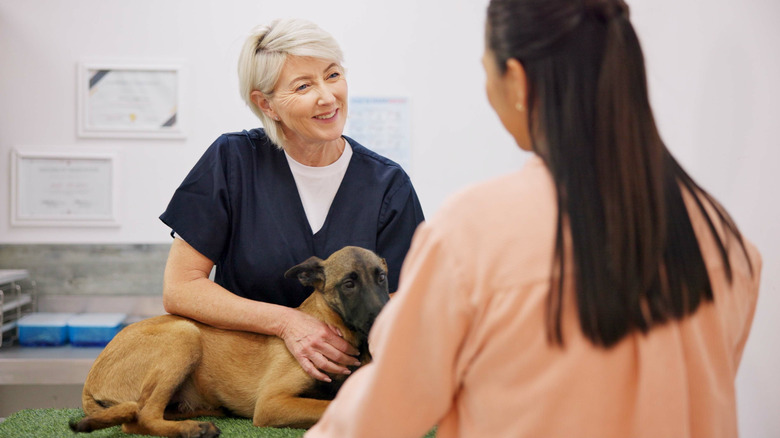When To Go To An Emergency Vet Vs. A Vet Clinic
There's nothing more stressful than watching your pet when they're sick or in pain. They cannot tell us verbally what's wrong, so it's on us to make the judgment call about how to care for them. Unfortunately, even if you're the kind of person who is always prepared with dog first aid kits, your pet may still require evaluation from a professional.
To ensure your pet receives proper care, it's important to understand the services offered by different providers. Your regular vet functions like a primary care doctor for your pet, which makes it great for regular checkups, vaccinations, and treating smaller problems. Emergency vets, meanwhile, employ doctors with specialized training, like surgeons, neurologists, and cardiologists. The offices tend to have more advanced equipment to help them diagnose a variety of complex health issues, including MRI machines. Emergency vets are usually open 24/7, or at least have extended hours compared to the regular vet's office. They exist to make sure your pet has access to care on weekends, holidays, and in the middle of the night. This can be particularly helpful since normal vet offices are usually only open during regular business hours and may have limited appointment slots.
Depending on the urgency of your pet's medical issue they may need immediate care. If your pet has diarrhea, a rash, or is refusing to eat without any other visible signs of distress, you can probably safely wait for an appointment. However, if you are trying to gauge the severity of your pet's condition in order to make a judgment call, there are a few tell-tale signs that your pet is having an emergency.
Symptoms that warrant a trip to the emergency vet
Though it's tempting to take your cat or dog to the emergency room every time they get a bit of diarrhea late at night, this isn't always necessary, nor is it the most practical option. Emergency vet rooms can become crowded quickly, which can result in extended wait times, especially if your pet's issue isn't life-threatening. Moreover, the cost of service is often significantly higher than normal vet bills. Because of this, visits to the emergency vet should be reserved for serious and life-threatening situations.
According to the Animal Emergency and Referral Center of Minnesota, some examples of serious symptoms you shouldn't ignore in your dog or cat include collapsing, difficulty breathing, limping, and seizures. Other signs of an medical emergency include coughing up blood or pink foam. These all point to different life-threatening issues. Another sign to look out for is panting, especially if it's not related to exercise. You can check this by setting a timer and observing how much your pet's chest raises when they're at rest. A resting respiratory rate of 60 breaths per minute or resting heart rate of more than 160 beats per minute could be a sign of heart disease, heat stroke, or shock, all of which require immediate medical attention.
Keep in mind that not all emergencies are obvious. One lesser-known symptom of a possible medical emergency is yellow gums, which could indicate a liver problem like jaundice. A bloated stomach, especially one that appears suddenly, can be a sign of a condition called gastric dilation volvulus, which can lead to shock if left untreated. If your dog has ingested any toxin; whether it's a chemical like a laundry pod, cleaner, or even human food like chocolate, that also requires immediate medical attention. If there's something not on this list that is worrying you, it's always okay to err on the side of caution and get your pet looked at by a professional.
How to prepare for an emergency vet visit
Thinking about emergency situations is not the most fun part of being a pet parent, but being prepared when the need for an emergency visit arises can prevent a ton of added distress. It's important to know which emergency clinic you'd go to so you have an action plan in place when the time comes. You don't want to be googling vet offices in a time-sensitive situation.
While you're doing your research ahead of time, it's also a good idea to take a look at the emergency vet's payment options, as emergency vet visits qualify as one of the hidden costs of caring for a pet. One of the best things you can do as a pet owner is prepare financially as much as possible in case an emergency arises. You may never have to use it, but adding a little bit each month to an emergency fund for your pet is a great way to stave off the shock and dismay at the bill that could come with a trip to the emergency vet. Insurance is a great option to have, too, as you can often get some of those vet expenses back. As for how much pet insurance costs for cats and dogs, that will depend on the company and the plan you choose.


